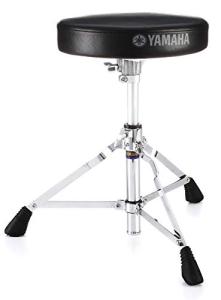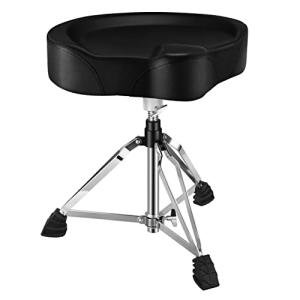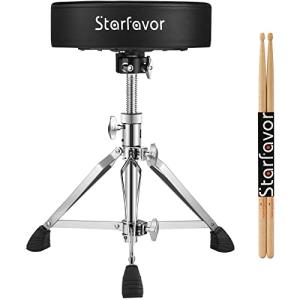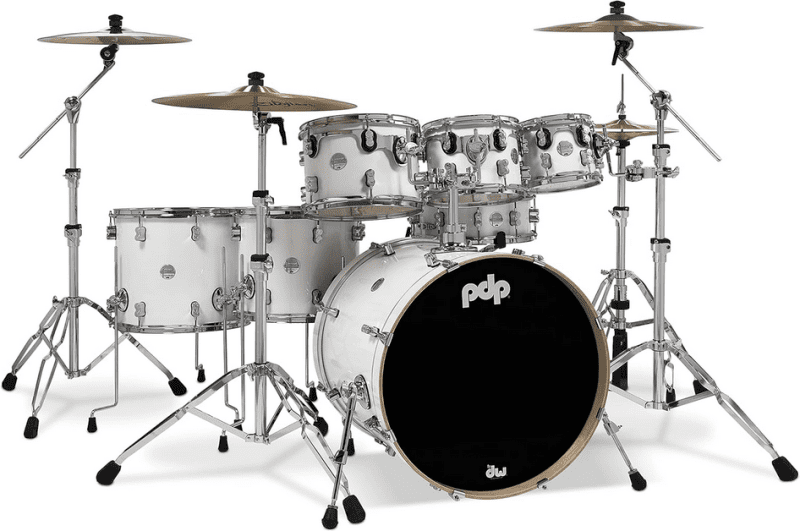"Kick Control: Finding the Perfect Drum Pedal for Your Kit"
Selecting the perfect drum pedal can make all the difference in your drumming experience. With various options on the market, it's easy to feel overwhelmed. This guide will simplify the process, helping you find a pedal that matches your style and enhances your performance.
Let's kick things off!

Key Takeaways
- Test different drum pedals like single chain, double chain, and direct drive to see which matches your playing style.
- Adjustable tension is key in a drum pedal for customizing the feel and response to suit you best.
- The material of the beater affects the sound: felt for warm tones, wood for balanced, plastic for punchy sounds.
- Ensure the drum pedal fits well with your kit and feels comfortable underfoot.
- Ask experienced drummers about their preferred pedals to help guide your choice.
Different Types of Drum Pedals
There are various types of drum pedals, including single chain drive, double chain drive, direct drive, and strap drive. Each type offers different features and benefits that cater to different playing styles and musical genres.
Single chain drive
A single chain drive pedal connects the footboard to the beater with one chain. This type of bass drum pedal is often lighter and has a simpler design than others. Drummers find it easy to use and repair, making it a good choice for beginners.
The action on these pedals feels smooth and they are usually more affordable than their double chain or direct drive counterparts.
Many drum kits come with a single chain drive pedal as standard equipment. They work well for various music styles and fit a tight budget without sacrificing quality. These pedals offer reliable performance and are common in both practice spaces and on stage.
Players can adjust them to match their drumming techniques and personal feel, which makes the single chain drive versatile for different percussion instruments.
Double chain drive
Double-chain drive pedals are known for providing added durability and stability compared to single chain options. They feature two chains connected to the footboard, offering a smooth and reliable pedal response ideal for diverse drumming styles.
The use of dual chains minimizes the risk of breakage during intense playing, making it suitable for heavy-hitters and those seeking long-lasting performance in their bass drum pedal.
Drummers favoring powerful strokes or rapid double kick techniques can benefit from the enhanced strength and consistency that a double chain drive pedal provides.
Additionally, double chain drive pedals are preferred by many rock, metal, and punk drummers due to their ability to handle aggressive playing styles while maintaining precision and speed.
With increased power transmission and reduced slack compared to single chain models, these pedals offer a solid foundation for energetic performances across various musical genres.
Direct drive
Direct-drive bass drum pedals offer a direct and responsive feel, enhancing speed and accuracy. Preferred by professional drummers in rock and heavy metal genres, they provide precise control for intricate footwork.
With adjustable tension and smooth action, these pedals cater to the demands of fast-paced playing styles, making them an ideal choice for advanced drummers seeking top-notch performance.
When choosing a bass drum pedal suitable for your playing style and performance needs, it's essential to understand the unique advantages of each type. Now let's explore another key type: "Strap Drive.".
Strap drive
Switching gears from direct drive, let's take a look at strap drive bass drum pedals. Strap drive pedals use a fabric or leather strap to transfer the motion from the footboard to the beater, providing a smooth and consistent feel.
These pedals are known for their flexibility and lightness, making them an excellent choice for drummers who prioritize speed and precision in their playing. Many jazz and fusion drummers find strap drive pedals well-suited to their intricate playing styles due to the subtle response they offer.
Additionally, these pedals often come with adjustable tension settings, allowing you to customize the feel of your pedal according to your preference.
Important Factors to Consider When Choosing a Drum Pedal
Consider your budget, playing style, the type of music you play, the size and weight of the pedal, and compatibility with your drum kit to ensure you choose the right drum pedal for your needs.
Read on to learn about the top features to look for in a drum pedal.
Your Budget
Consider your budget when selecting a drum pedal, as it will narrow down your options significantly. Single-chain drive pedals are generally more budget-friendly than double-chain or direct-drive pedals, making them suitable for beginners or those on a tight budget.
However, if you have the flexibility to invest in a higher-end pedal, direct-drive pedals may offer better durability and responsiveness over time. Keep in mind that while setting a budget is important, it's also essential to strike a balance between cost and quality to ensure long-term satisfaction with your purchase.
When considering your budget for a drum pedal, factor in any additional accessories you may need such as replacement beaters or pedal adjustments. Opting for a mid-range pedal with room for future upgrades can be an economical choice in the long run.
Your Playing Style
Consider your playing style when choosing a drum pedal. The type of music you play and your personal style greatly influence the pedal that will best suit you. For example, if you prefer fast double-kick techniques common in heavy metal or rock genres, a direct drive or double chain pedal may be more suitable for providing the speed and power you need.
Conversely, if you play jazz or require greater feel and control, a strap drive or single chain pedal might be the better choice to accommodate intricate footwork and nuanced dynamics.
Adjust the bass drum pedal according to your playing style preference. Ensure it complements your technique and enhances your performance by providing the right balance between speed, power, control, and feel based on the musical styles you commonly play.
The Type of Music You Play
Consider the style of music that you play when choosing a drum pedal. For instance, if you play fast-paced genres like metal or rock, a direct drive pedal may offer the speed and power necessary.
On the other hand, if you're into jazz or softer styles, a chain-drive pedal with customizable tension might be more suitable for nuanced playing.
Ensure to explore which type of drum pedal best complements your preferred musical genre to enhance your overall performance and experience.
The Size and Weight of the Pedal
Consider the weight and size of the pedal, ensuring it feels comfortable under your foot. Look for a durable yet lightweight material like aluminum or steel. A heavier pedal may provide stability but can be tiring during long sessions.
A lighter pedal might offer greater speed and maneuverability for intricate footwork. The right weight and size balance will enhance control without causing fatigue, improving overall performance.
When considering the size and weight of the pedal, its impact on playing style and endurance cannot be overstated. Now let's delve into discussing the compatibility of the pedal with your drum kit.
Compatibility With Your Drum Kit
Ensure the bass drum pedal is compatible with your drum kit. Consider the pedal's attachment mechanism and whether it fits securely. Look for compatibility with both acoustic and electronic drum kits to ensure versatile usage.
Check for adjustability to accommodate different setups, ensuring a seamless integration.
When choosing a bass drum pedal, ensure its compatibility with your specific musical needs and playing style while keeping in mind any potential future upgrades or modifications to your drum kit setup.
Look for features such as adjustable hoop clamps and extension options for versatility in fitting various sizes of bass drums and pedals.
Top Features to Look for in a Drum Pedal
- Look for a drum pedal with adjustable tension, various beater options, a durable footboard design, and additional accessories to enhance your playing experience. Find out more about the top features to consider when choosing the right drum pedal for your kit by reading the full article.
Adjustable Tension
Adjustable tension is a crucial feature to look for in a drum pedal as it allows you to customize the feel and response of the pedal according to your playing style and preference.
This feature enables you to adjust the spring tension, providing greater control over the rebound and power. When choosing a bass drum pedal, consider one with adjustable tension so that you can fine-tune it to match your specific needs, whether for speed, power, or precision.
The ability to adjust the tension ensures that the pedal suits different musical styles and playing techniques without compromising on comfort or performance.
Considering adjustable tension when selecting a bass drum pedal is essential for tailoring its responsiveness and feel to suit your personal playing style and desired sound output.

Beater options
Consider beater options such as felt, wood, or plastic for different sounds. A felt beater produces a warm and round tone suitable for jazz and softer music styles. On the other hand, a wood beater offers a balanced sound that suits various music genres.
For a more defined and punchy attack, opt for a plastic beater ideal for rock and heavier music styles. Be mindful of the impact these options have on the pedal's responsiveness.
When testing out different bass drum pedals, pay attention to how each type of beater feels against the drumhead to find your desired sound. The material and shape of the beaters can significantly influence your playing experience based on the type of music you perform.
Experimenting with various beater options will help you discover which one complements your playing style and musical preferences effortlessly.
Footboard Design
The footboard design of a drum pedal is crucial for comfort and performance. Look for a smooth, flat footboard that allows your foot to move freely. Consider the material of the footboard – aluminum and steel are common options offering durability without excessive weight.
Choose a textured footboard if you prefer extra grip during intense playing sessions.
To customize your playing experience, opt for a drum pedal with an adjustable footboard angle. This feature lets you align the pedal to match your natural ankle motion, reducing strain during extended playing periods.
Durability
Consider the material used in the pedal construction, such as aluminum or steel, to gauge its strength and longevity. This can impact how well it withstands prolonged use and heavy playing.
Research different brands and models to find a pedal that offers durability within your budget while meeting your specific bass drum pedal needs.
Additional accessories
When considering additional accessories for your drum pedal, look for options like impact pads to protect the bass drum head and enhance the beater's impact. Some pedals offer interchangeable cam options allowing you to customize the feel and response of the pedal according to your playing style.
Additionally, consider investing in a reliable drum key and spare springs for easy maintenance and quick adjustments on-the-go. These accessories can enhance your overall playing experience by providing flexibility, protection, and convenience.
To further elevate your performance, explore add-ons such as toe stops or spikes for added stability during vigorous playing, along with strap drive conversion kits if you prefer that over chain-driven pedals.
Tips for Testing and Choosing the Right Drum Pedal
Try out different pedals at your local music store, consider your personal preference, and ask for recommendations from experienced drummers to find the perfect drum pedal for your kit.
To learn more about how to choose the right drum pedal for your needs, keep reading!
Try out different pedals
Explore a variety of pedals to find the one that matches your playing style and comfort. Test single chain, double chain, and direct drive pedals for a feel of their different responses.
Experiment with various beater options and footboard designs to determine which suits your preferences best.
Consider the type of music you play when testing different pedals to gauge their suitability for your genre. Pay attention to adjustability features like tension and beater angle as well as durability when trying out different pedal models in stores or at studio spaces.
Consider Personal Preference
When choosing a drum pedal, consider your personal preference in terms of feel and responsiveness. Your playing style and the type of music you play will influence the choice between single-chain, double-chain, or direct-drive pedals, affecting speed and power.
The adjustable tension and footboard design are important for customization to suit your specific needs. Additionally, seeking recommendations from experienced drummers can provide valuable insights into finding a suitable pedal that aligns with your preferences while offering durability and performance.
Ask for recommendations
When choosing a drum pedal, seek guidance from experienced drummers and professionals at music stores. Their insights can help you narrow down the options that best suit your playing style, budget, and music genre.
Pay attention to their recommendations as they can offer valuable advice on selecting the right bass drum pedal for your specific needs.
Consider exploring different brands and models with varied features to find the best bass drum pedal for your setup. Talking to knowledgeable individuals will provide you with diverse perspectives and help you make an informed decision when purchasing a new drum pedal.
Conclusion
In conclusion, selecting the right drum pedal involves considering your playing style and the music you play. Factors such as budget, weight, and durability are also crucial in finding a suitable pedal.
Look for adjustable tension, beater options, and compatibility with your drum kit. Don't forget to test different pedals and seek recommendations from experienced drummers before making your decision.
Making an informed choice will help you find the perfect drum pedal that complements your kit and enhances your performance.
FAQs
1. What should I consider when choosing a drum pedal for my kit?
Think about the bass drum pedal features like speed, comfort, and whether you want a single or double bass pedal for your musical equipment.
2. Is there a difference between pedals for electronic and acoustic drums?
Yes, some pedals work better with electronic drums because of their design so pick the best pedal that matches your type of drum set.
3. Can beginners use the same pedals as pro players?
Beginners can start with budget-friendly and simple-to-use drum pedals before moving on to more advanced options as they improve.
4. How do I know if I need a double kick pedal?
If you play music that requires fast and complex beats, then comparing double kick pedal options could help find one that suits your playing style.
5. Where can I find tips for picking the right jazz drum pedal?
Look at guides to finding the perfect drum pedal where factors such as weight, responsiveness, and feel are compared especially for jazz genre needs.








